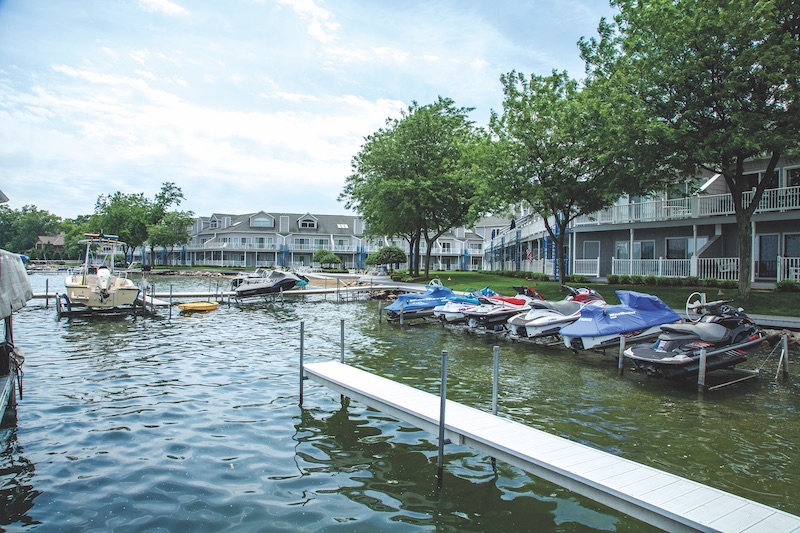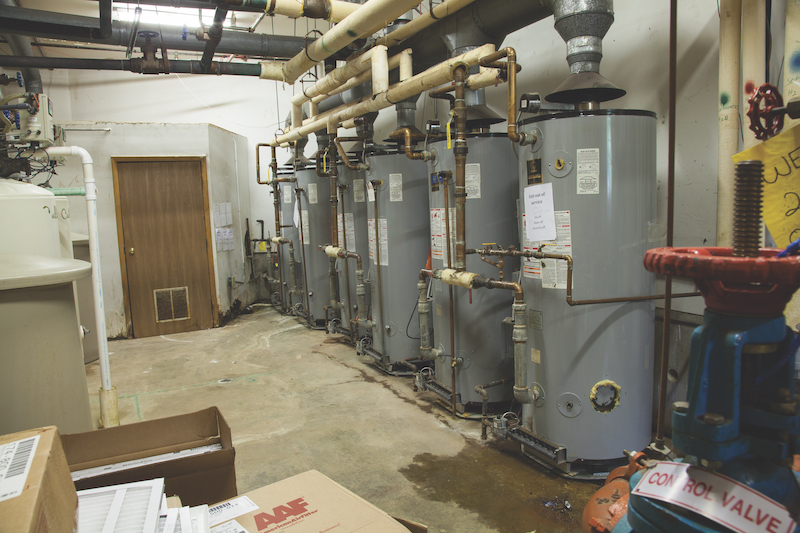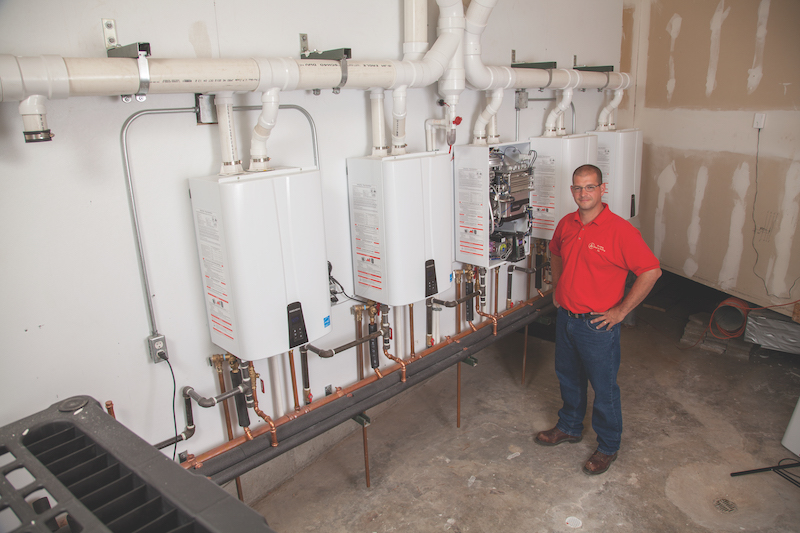Culver Cove is an 80‑unit condo complex located on Lake Maxinkuckee near Culver, Ind.
Originally hot water was supplied from three strategically located utility rooms, each with six 100‑gallon commercial tank‑type heaters. Circulating pumps and mixing valves were required to prevent scalding. Rich West, Executive Director of Culver Cove, was looking for a more efficient hot water system to reduce energy costs, especially during low demand periods. His research led him to the Navien Premium Efficiency (NPE) tankless water heaters that would eliminate the energy cost of constantly running the tanks to be ready for hot water demand.
 West worked with Mike Lambert, then with Mid-City Supply Co., and Clark Boyles of P-M & Associates, the Navien distributor and rep in northern Indiana. They recommended a phase one installation of five cascaded Navien NPE-240A units for about one-third of the complex—about 26 units, from one to three bedrooms each. With the proven energy savings of the first phase, Culver Cove proceeded to change out the other two utility rooms that served the rest of the condos.
West worked with Mike Lambert, then with Mid-City Supply Co., and Clark Boyles of P-M & Associates, the Navien distributor and rep in northern Indiana. They recommended a phase one installation of five cascaded Navien NPE-240A units for about one-third of the complex—about 26 units, from one to three bedrooms each. With the proven energy savings of the first phase, Culver Cove proceeded to change out the other two utility rooms that served the rest of the condos.
 Culver Cove, an 80-unit condo community in Culver, Ind., installed Navien tankless water heaters to improve its overall energy efficiency.
Culver Cove, an 80-unit condo community in Culver, Ind., installed Navien tankless water heaters to improve its overall energy efficiency.
Lambert and Boyles worked with Jason Richards, Owner of A+ Plumbing Heating and Cooling, to work out details for sizing, designing, and installing the system. The installation of each section took about a week and a half, including removing the old tanks. The five Navien units used two sets of four-inch PVC vent pipes that ran through the roof in an existing 12‑inch B vent.
BENEFITS OF NAVIEN NPE TANKLESS SYSTEM
Efficient hot water supply. “The five Navien units are cascaded so when the master unit comes on, it triggers the next one in line to help as needed, and so on until all units are running if necessary,” said Richards. “Each time a Navien unit comes on, it’s a different master-slave situation, so all five units have equal run times.”
Technical factors. “Unlike the old tank system, we could eliminate the external circulating pump and mixing valve, since we can set the temperature at 120 degrees,” said Boyles. Another factor in selecting Navien NPE-A tankless water heaters was the internal recirculating pump and buffer tank, which assure an uninterrupted flow of hot water.
 Old conventional water heaters at Culver Cove condominiums were replaced to improve energy efficiency.
Old conventional water heaters at Culver Cove condominiums were replaced to improve energy efficiency.
Energy and water savings. “We have noticed a decrease in our energy cost from NIPSCO, our local gas supplier—a real dollar savings every month,” said West. “We have applied for an energy rebate. I also have seen a decrease in our domestic water use.”
Easier installation. “One of the main reasons we went with Navien is the ability to use PVC,” Richards said. “The common venting also makes it less expensive. In this retrofit situation, we could use existing penetrations to run our vents. That saved a lot of labor.”
For more information: NavienInc.com.
Related Stories
| Feb 10, 2011
Moen M•Power electronic faucets
At 0.5 gpm, Moen’s M•Power electronic faucets meet the current standards, and offer features that eliminate waste. Improved electronic sensors reduce reflectivity to stop false sensing, and turn off automatically after 30 seconds. Electronics can be installed above or below deck to accommodate different sink styles.
| Jan 21, 2011
Virginia community college completes LEED Silver science building
The new 60,000-sf science building at John Tyler Community College in Midlothian, Va., just earned LEED Silver, the first facility in the Commonwealth’s community college system to earn this recognition. The facility, designed by Burt Hill with Gilbane Building Co. as construction manager, houses an entire floor of laboratory classrooms, plus a new library, student lounge, and bookstore.
| Dec 2, 2010
Alliance for Sustainable Built Environments adds Kohler's Robert Zimmerman to Board of Directors
Robert Zimmerman, Manager – Engineering, Water Conservation & Sustainability at Kohler Co., in Kohler, Wisconsin, has joined the Board of Directors of the Alliance for Sustainable Built Environments. In his position at Kohler Co., Rob is involved with all aspects of water conservation and sustainability related to plumbing fixtures and faucets.
| Nov 9, 2010
U.S. Army steps up requirements for greening building
Cool roofs, solar water heating, and advanced metering are among energy-efficiency elements that will have to be used in new permanent Army buildings in the U.S. and abroad starting in FY 2013. Designs for new construction and major renovations will incorporate sustainable design and development principles contained in ASHRAE 189.1.
| Nov 3, 2010
Park’s green education center a lesson in sustainability
The new Cantigny Outdoor Education Center, located within the 500-acre Cantigny Park in Wheaton, Ill., earned LEED Silver. Designed by DLA Architects, the 3,100-sf multipurpose center will serve patrons of the park’s golf courses, museums, and display garden, one of the largest such gardens in the Midwest.
| Nov 3, 2010
Public works complex gets eco-friendly addition
The renovation and expansion of the public works operations facility in Wilmette, Ill., including a 5,000-sf addition that houses administrative and engineering offices, locker rooms, and a lunch room/meeting room, is seeking LEED Gold certification.
| Nov 3, 2010
Sailing center sets course for energy efficiency, sustainability
The Milwaukee (Wis.) Community Sailing Center’s new facility on Lake Michigan counts a geothermal heating and cooling system among its sustainable features. The facility was designed for the nonprofit instructional sailing organization with energy efficiency and low operating costs in mind.
| Nov 3, 2010
Senior housing will be affordable, sustainable
Horizons at Morgan Hill, a 49-unit affordable senior housing community in Morgan Hill, Calif., was designed by KTGY Group and developed by Urban Housing Communities. The $21.2 million, three-story building will offer 36 one-bed/bath units (773 sf) and 13 two-bed/bath units (1,025 sf) on a 2.6-acre site.
| Nov 3, 2010
Virginia biofuel research center moving along
The Sustainable Energy Technology Center has broken ground in October on the Danville, Va., campus of the Institute for Advanced Learning and Research. The 25,000-sf facility will be used to develop enhanced bio-based fuels, and will house research laboratories, support labs, graduate student research space, and faculty offices. Rainwater harvesting, a vegetated roof, low-VOC and recycled materials, photovoltaic panels, high-efficiency plumbing fixtures and water-saving systems, and LED light fixtures will be deployed. Dewberry served as lead architect, with Lord Aeck & Sargent serving as laboratory designer and sustainability consultant. Perigon Engineering consulted on high-bay process labs. New Atlantic Contracting is building the facility.
| Nov 1, 2010
Vancouver’s former Olympic Village shoots for Gold
The first tenants of the Millennium Water development in Vancouver, B.C., were Olympic athletes competing in the 2010 Winter Games. Now the former Olympic Village, located on a 17-acre brownfield site, is being transformed into a residential neighborhood targeting LEED ND Gold. The buildings are expected to consume 30-70% less energy than comparable structures.















